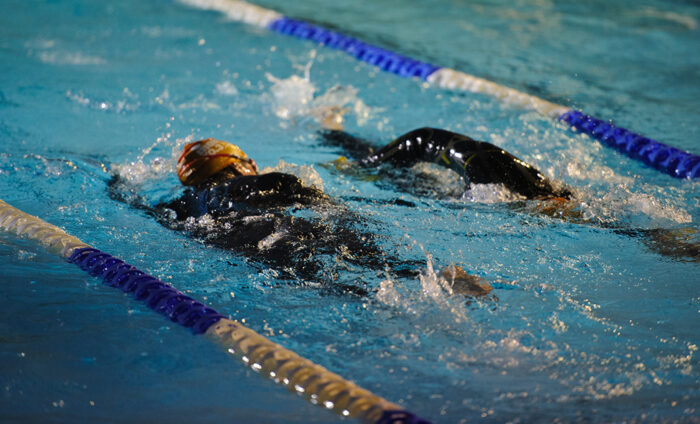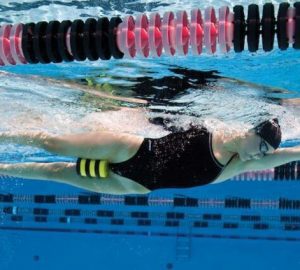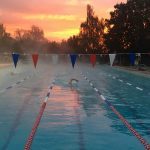
Protect your winter gains
A well-invested block of training during spring will help convert a solid winter of training into performance gains for the upcoming open water season. But, unless you pay attention, you can quickly lose speed when you swap winter pool-based sessions for the delights of summer swimming outdoors. Hopefully, you will have been developing your endurance, pacing skills and sustainable speed along with correcting technical issues in your stroke to become more efficient in the water over the winter. Protecting the gains made over the previous six months should become a priority in the summer.
When swimming in open water there’s a tendency to relax your focus on accurate pacing and excellent technique, both of which are detrimental to speed. In addition, if you don’t brush up and hone your open water skills, you will also be at a disadvantage. My suggested sessions this issue therefore focus on pacing and open water skills to ensure you make the most of all the training you’ve done through the winter.
If you’ve been following my training sessions you will know I place a lot of emphasis on critical swim speed (CSS), which is your threshold or sustainable swimming pace. You CSS in open water will be different to the pool, especially if you wear a wetsuit which results in a significantly faster CSS for many swimmers. You will also be affected by sighting and the lack of turns.
For those seeking to maximise performance in open water, ideally your endurance training session each week should now be taken outdoors and completed in a wetsuit if that’s what you use for racing. In my SwimSmooth Richmond squad we see an improvement of up to 20 seconds per 100m with wetsuit use. Those with non-swimming backgrounds tend to benefit the most from the improved buoyancy and body position whereas some very experienced swimmers can feel completely unbalanced. It is essential to understand how swimming with a wetsuit affects your speed so you can train at the correct pace.
Secondly, having confidence and competence in deploying open water skills requires practice. But it’s worth noting that practice does not make perfect, but rather, permanent! So ensure that you utilise skill and strategy practice relevant to your particular stroke anomalies. The difference between being skilled at open water strategies or not will determine whether you can execute the desired swim times in racing based on your (wetsuit) open water CSS in training. Enjoy working on both critical aspects in the sessions below.
Session 1 – Pace awareness
(Do in a wetsuit if that’s what you use for racing)
Warm up: 3x400m stroke rate contrast set as:
1. 400m FS at easy, relaxed stroke rate (2-3 Strokes per Minute (SPM) below your Base Stroke Rate (BSR)) focusing on consistent exhalation and effective breathing technique.
2. 400m FS at BSR or normal stroke rate rhythm, practising versatility in breathing patterns (bilateral, unilateral, 3/2/3/2).
3. 400m FS at a slightly elevated stroke rate (2-3 SPM above your BSR); experiment with a more open and relaxed arm recovery and finishing stroke to thighs
Take 30-60s rest after each 400m
Main set 1: TIMED SWIM
1,000m FS at fastest sustainable pace
Calculate your average pace per 100m after the session, to use for training sets in open water. If you wear a wetsuit this may be a vastly different pace to your non-wetsuit CSS. It is important to have an accurate pace to use in open water with a wetsuit.
60 seconds rest
Recovery set:
200-400m easy FS (relaxed stroke rate) with paddles, ensure stroke is finished to thighs
30 seconds rest
Main set 2:
6 to 10x100m drafting in pairs or small groups (3-4 swimmers) practising hip and feet drafting positions. Lead swimmer to dictate pace, varying from CSS to sprint over each 100m to provide non-static speed for drafting swimmers to dial in drafting skills, observation skills and anticipation of pace changes. Swap leader after each 100m. Work on close drafting and versatile breathing patterns to ensure lead swimmer is kept in sight to not become dropped!
Cool down: 200-400m easy. Include some backstroke
Session 2 – Open water skills
Total distance: 3,200 to 4,000m
Warm up: 5x200m as:
1. 200m easy aerobic pace
2. 200m FS, open turns no wall push off. Work on re-establishing stroke rate rhythm after each turn.
3. 200m FS, sighting every 6 or 8 strokes. Practise co-ordination of brief sight forward before turning head to breathe in.
4. 200m FS, hip drafting a partner, breathe towards them to monitor speed, proximity and co-ordinating stroke rate around theirs
5. 200m FS, as 4) but swap leader. Breathing pattern 3/2/3/2 working at CSS pace
Main set 1:
10x100m at CSS pace (from session 1). Deep water starts and no wall push off. Practise a range of turns (backstroke flip turn or single arm turn) +15 sec rest in between
Main set 2:
2 to 3x500m drafting practice, swapping lead every 100 to 200m. Utilise sighting to remain on the feet or breathe towards partner if hip drafting to remain in good proximity and benefit from up to 20% in energy saving, in their draft.
60s rest after each 500m
Cool down: 200-500m easy, include some backstroke.
Open water option:
Both of these sessions can be adapted to open water. You may need to be a bit creative to mark out a measured course but use GPS or maps to measure distances between buoys and landmarks and set up loops or out and back routes of say 400m, 750m or 1000m.
Guidance notes
CSS – Critical Swim Speed. Effectively training at your threshold pace provides you with significant speed efficiency gains
Pacing – using the pool clock, your own stopwatch or a timing device such as a Finis Tempo Trainer or Wetronome
BB = Bilateral Breathing
UB = Unilateral Breathing
BS = Backstroke
FS = Freestyle or front crawl
BRS = Breaststroke
FLY = Butterfly
PULL = Swimming with a pullbuoy or float between your legs. No kicking.






